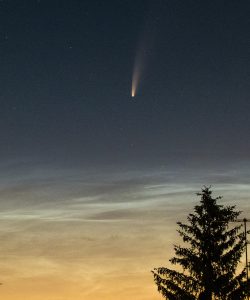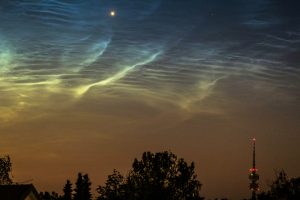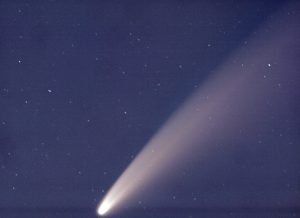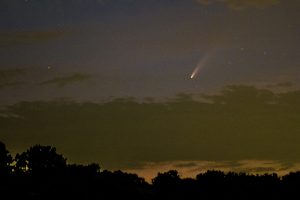C/2020 F3 (NEOWISE) Introduction
A new Comet C/2020 F3 (NEOWISE) has suddenly become visible to the unaided eye,
overshooting its brightness predictions. It is the first one visible to the naked eye in this millennium and expected to remain so in July. NEOWISE was discovered in late March and brightened as it reached its closest approach to the Sun, inside the orbit of Mercury, late last week.
The Comet C/2020 F3 (NEOWISE), is a retrograde comet with a near-parabolic orbit discovered on March 27, 2020. Comets are icy bodies in space that release gas or dust. They are often called dirty snowballs, though after careful research some scientists prefer to call them snowy dirtballs. Comets contain dust, ice, carbon dioxide, ammonia, methane and more. Comets orbit the sun, but most are believed to inhabit in an area known as the Oort Cloud, far beyond the orbit of Pluto. Occasionally a comet streaks through our inner solar system; some do so regularly, some only once every few centuries.
C/2020 F3 (NEOWISE) details
As of July the comet has brightened to magnitude +1, currently fading to 1,4, 1.5 and 1.8 mag. C/2020 F3 (NEOWISE) is circumpolar and never sets from Munich, however visibility is limited by sun and moon.
The comet remains deep in the twilight morning and soon evening glow having recently passed Perihelion. It slowly heads north out of twilight through the constellations of Auriga, Lynx and Ursa Major through July; ideally placed for northern hemisphere observation. Localized key information can be seen on a my customized quick access page at skylive.
Many amateur astronomers (like me) were a bit skeptical about the forecasts (which underestimated the brightness), given that two previous comets had very similar forecasts then fizzled out once they got too close to the Sun. Some in the field held the belief this one might just put on a better show and it appears to be following that path. The light curve of Comet Neowise shows more promise than the light curves of the other two comets. But Icarus and dirty snowballs always have had an unknown future… last two promising comets broke apart (approaching the sun however). Below there is a gallery – updated after ever observation – with some of my shots.
C/2020 F3 (NEOWISE) gallery
The gallery pictures were mostly done with Canon 60Da and 300mm/5.6 zoom lens, one second with ISO1600 on a sturdy photo mount, or 5-15 seconds or with an Atik Horizon I Camera through a TMB 80/600 Refractor and UHCS filter.
Observation log of Comet C/2020 F3 (NEOWISE)
On my first sight of the Comet NEOWISE its brightness of around 1 mag (currently down to 1.4/ 1.5/1.8) made it easy to observe. He almost jumped at me in binoculars and has a pretty tail. The future brightness of Comet NEOWISE remains as usual uncertain. It will be soon not only visible in the early morning sky, but also next week in the early evening sky.
As the comet approaches the earth, it will be visible also in the evening and pulls from the constellation Auriga into the Big Dipper, visible in the evening from 11:30 p.m. It will reach its closest position on earth on July 23 – but since it is just moving away from the sun again, it already started be become weaker not brighter.
Wednesday Morning,7/8/2020
All pictures are from my office window in Munich, not ideal light conditions. The bright Auriga alpha star Capella and not far the Menkalinan show the way. In the early morning sightings, all one has to do is turn a bit left from Capella North East and down perpendicular in direction horizon.
I saw the comet with its steeply rising tail first in the binoculars and after I knew its position in relation to trees was able to make it out with bare eyes. Observation was best right at the beginning when the comet rose above 5 degrees, around 3:00 am, when the NLCs were barely lit up yet.
For the next one and a half hours, until about four o’clock the comet became increasingly spectacular sight. Observing the comet was significantly hampered by the Noctilucent clouds (NLC) but they added a spectacular moody background. Noctilucent clouds, or night shining clouds, are tenuous cloud-like phenomena in the upper atmosphere of Earth. They consist of ice crystals and are only visible during astronomical twilight.
Friday Morning,7/10/2020
After one night with rain, clouds (and sleep) another observation night . without lightening clouds yielded less spectacular but wonderful views. This time I mainly used TMB 80/600 refracting telescope (APO) and my Atik Horizon with an UHCS broadband filter.
Sunday Morning,7/12/2020
Although the forecast promised clouds, it cleard up during the night another observation night twas possible. This time I mainly used TMB 80/600 refracting telescope (APO) and my Atik Horizon with an UHCS broadband filter.
Sunday Evening,7/12/2020
I tried my first evening observation at a nearby park and saw the comet with its steeply rising tail first in the binoculars just abov the treeline. Observation was best right at the beginning when the comet was still above 5 degrees, around 10:00 pm / 22:00 in the dusk twilight.
Thuesday Evening,7/14/2020
I do now regularly evening observations, as the comet is circumpolar. Equally easy to find, all one has to do is turn a bit left from Polaris North West and down perpendicular in direction horizon. Before the big rain came I went out with the bike to find good observation site. After two hours biking/hunting for a good background location, I settled for plan B. That’s a park around Palace Nymphenburg, 5 minutes from home. I often walk my dog at the meadows around the park around Palace Nymphenburg where there is a large area without lamps (the park itself is closed during night time). North direction is not too bad for a city. Just before the rain came a little opening between the clouds appeared. I knew where to expect the comet, and waited until it came down from the upper dark cloud. Actually the lower clouds blocked out the astronomical twilight.
Mondy Evening,7/13/2020
Video Comet C/2020 F3 (NEOWISE) on July 8th.
A video of the magic night with noctilucent clouds (NLC) combined the spectacular, extremely colorful and bright pictures of July 8th 2020.
The JPGs straight from the camera actually show already everything.
Credits belog to a fellow member of my local observatory show in the video. For best view you should switch the
following video to full screen.
Of course, the reality was even better than videos and pictures together. The sight in my 10×50 binoculars was stunning. When the comet is in the night sky the next week and the moon is gone, we look forward to a good show. Keep fingers crossed.
Comets: Facts About The ‘Dirty Snowballs’ of Space



